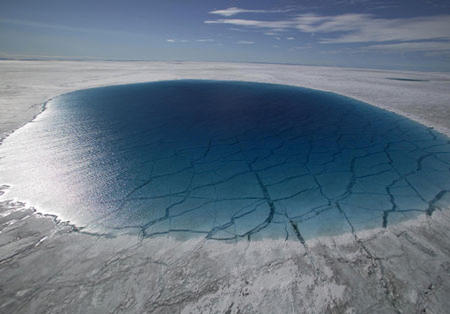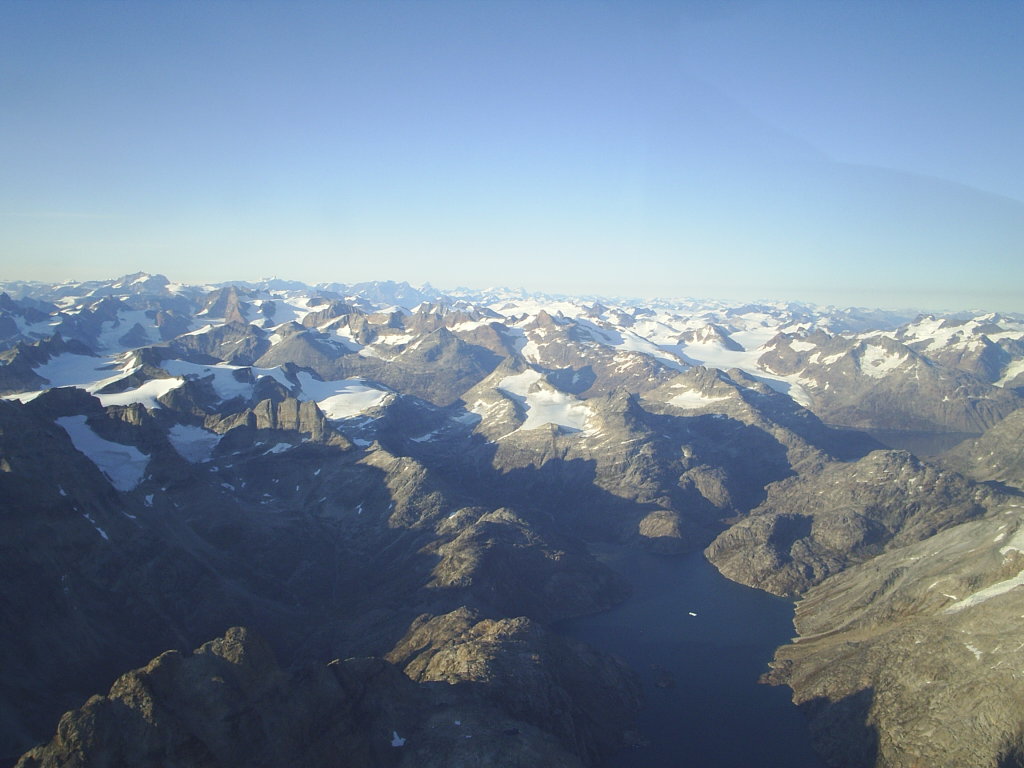Greenland Ice Cap
Melting



The continent of Greenland lies at the very epicenter of the rapidly escalating Global Warming phenomenon.
The "island" is one of the largest reservoirs of fresh water (and ice) on Earth and holds roughly 10% of the world's supply. Antarctica contains roughly the remaining 90%. Only a very, very small percentage of the world's fresh water is comprised of streams, lakes, atmospheric rain, rivers and underground aquifiers, through which humanity meets its drinking, agricultural and industrial water requirements.
Greenland sits at the very center of the Global Warming crisis for 3 very critical reasons; 1) Its landmass is located south of the North Pole, closer to the equator and is, therefore, more suseptible to the sun's melting rays- as compared to Antarctica, which sits at the most extreme and isolated circumpolar region of Earth, known as the South Pole. 2) The consequences of melting Greenland glaciers threatens to disrupt the flow of the North Atlantic Current, which brings in warmer tempuratures from the equator to the European Continent. The United Kingdom is particularily vulnerable, due to its northern geography as well as to its location and proximity to the eastern Greenland coastline area, which is experiencing the most melting and runoff. 3) The continent of Greenland is situated in the northern hemisphere of Earth, where the majority of the planet's land-masses and most developed industrial nations reside. Therefore, within the planet's weather, heat exchange and ocean current grids, its cause and effect will be felt the greatest here in this particular hemisphere.
Thus noted, Greenland's ice cap is melting 3 times faster than it was only 5 years ago, and in the near future the pace of melting will accelerate even more due to loss of albido and higher polar air tempuratures among other factors. The concentration of carbon dioxide (CO2), the main greenhouse gas that is driving climate change, has reached its highest level in 650,000 years. This concentration has increased from a pre-industrial level of roughly 280ppm (parts per million of CO2) to between 380ppm-430ppm in 2007.
Out of Greenland's 844,000 square miles, 85% is covered by an ice cap up to 10,000 ft. thick in some places. If the Greenland Ice Cap melted completely, the world's sea level would rise by 25 feet. Already this past century, due to melting ice in the Arctic, Antarctica and from Greenland, the ocean levels have risen a staggering 20 inches. According to geophysicist Michael Oppenheimer of Princeton University in the USA, "the time scale for future loss of most of an ice sheet may not be millenia, but centuries".
In 2006, estimated monthly changes in the mass of Greenland's Ice sheets suggest that it is melting at a rate of about 239 cubic kilometers (57.3 cubic miles) per year. Most of this melting occurs between April and September, while peaking in August. According to James Hansen of NASA's Goddard Institute for Space Studies, global CO2 emissions must be stabilized within a decade or it will become warmer on Earth than it has been for the past half million years. Intergovernmental panels have predicted that average global tempuratures will rise to between 2-11 degrees farenheit in the 21st century if greenhouse gas emissions are not soon curtailed. 12 of the last 13 years (1995-2007) rank among the 12 warmest years on record since 1850.
Clearly, the spectre of Global Warming will lead to an increase in weather related catastrophes and anomolies such as; drought, heat waves, flooding (in certain areas), hotter summers, warmer winters, melting glaciers, rising sea levels, loss of biological diversity, animal habitat flight, increased insect population and communicable diseases, more frequent and intense storms, tornadoes and hurricanes, severe water shortages, coral reef bleaching, possible 'ice age' incursions and expansions into certain areas (such in the UK and Northern Europe) and a general disruption of the Earth's natural cyclical, geophysical and equilibrial balance.
Solutions. The final version of the Intergovernmental Panel on Climate Change (IPCC) issued May 4th, 2007 states that carbon emissions can be cut well below current levels if the world's nations (principally the USA, China and India- the largest CO2 emitters) shift immediately away from fossil fuels and into an alternative energy economy- such as with wind, solar, hydrogen, fuel cell and anti-gravitic energy technologies. As well, deforestation practices must be halted dramatically and reforestation efforts intensified planetwide, so as to increase the carbon sink potential to trap CO2 from the atmosphere. Lastly, a $1.2 trillion dollar global military defense budget for war, weapons and needless conflict, death and destruction, must be IMMEDIATELY terminated and re-directed into creating a just, humane, sustainable, non-polluting, highly managed and advanced world civilization for Mankind for the 21st century.
Steve Jones
Mount Shasta, California
USA
Planet Earth













